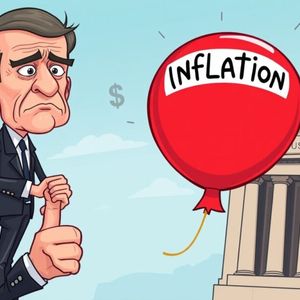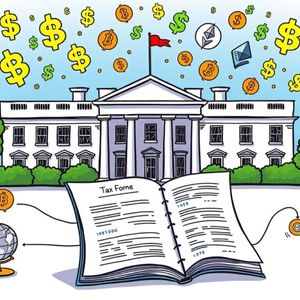BitcoinWorld Fed Inflation Target: Powell’s Crucial Update on US Economy’s Robust Health In the dynamic world of finance, few pronouncements carry as much weight as those from the Federal Reserve. When Federal Reserve Chair Jerome Powell speaks, markets listen, and the cryptocurrency space is no exception. Recently, according to JinSe Finance, Chair Powell delivered a significant update, stating that while the U.S. economy stands in a solid position, the persistent challenge of inflation remains slightly above the Fed inflation target. This seemingly subtle detail holds profound implications for investors, businesses, and indeed, the future trajectory of digital assets. Understanding the Fed Inflation Target and Its Significance To truly grasp the impact of Powell’s statement, it’s essential to understand what the Fed inflation target is and why it’s so critical. The Federal Reserve aims for an average inflation rate of 2% over the long run, as measured by the Personal Consumption Expenditures (PCE) price index. This 2% target isn’t arbitrary; it’s considered the ‘Goldilocks zone’ – high enough to avoid deflation (a dangerous spiral of falling prices and economic contraction) but low enough to maintain price stability and protect the purchasing power of the dollar. The Fed operates under a ‘dual mandate’ from Congress: to achieve maximum employment and maintain stable prices. These two goals are often intertwined. When inflation is too high, it erodes the value of money, making goods and services more expensive and reducing the real income of households. This uncertainty can dampen consumer spending and business investment, ultimately hindering economic growth and employment. Therefore, keeping inflation in check is paramount to the Fed’s mission. Powell’s acknowledgment that inflation remains ‘slightly above target’ signals that while progress has been made from the multi-decade highs seen recently, the battle is not yet won. This continued vigilance means that monetary policy, which directly influences interest rates and liquidity, will remain a key factor shaping the economic landscape. Jerome Powell’s Assessment: A Robust US Economy? Chair Powell’s description of the U.S. economy being in a ‘solid position’ offers a counterpoint to the inflation concerns. What exactly contributes to this robustness? Typically, a ‘solid’ economy is characterized by several key indicators: Strong Labor Market: Low unemployment rates and consistent job creation indicate a healthy demand for labor, reflecting business confidence and consumer spending capacity. Resilient Consumer Spending: Consumer expenditure accounts for a significant portion of U.S. GDP. Consistent spending suggests consumer confidence and financial stability. Steady GDP Growth: A positive and stable Gross Domestic Product (GDP) growth rate signifies an expanding economy, increasing productivity, and overall prosperity. Corporate Earnings: Healthy corporate profits can lead to increased investment, hiring, and stock market performance. While the U.S. economy has demonstrated remarkable resilience in the face of various global challenges, including supply chain disruptions and geopolitical tensions, the ‘slightly above target’ inflation figure acts as a persistent thorn. It implies that while growth is present, the underlying inflationary pressures are proving more stubborn than anticipated. This creates a delicate balancing act for the Fed: how to cool inflation without stifling the very economic strength they aim to preserve. Consider these recent trends that contribute to Powell’s assessment: Economic Indicator Current Trend (General) Implication for ‘Solid Position’ Unemployment Rate Historically Low Strong job market, high employment GDP Growth Positive and Steady Economic expansion continues PCE Inflation Decreasing but Above 2% Progress, but still a concern for the Fed inflation target Consumer Spending Resilient Key driver of economic activity This nuanced view from Powell underscores the complexity of managing a large, dynamic economy, where conflicting signals require careful interpretation and strategic policy responses. Why the Fed Inflation Target Matters for Cryptocurrency For those deeply invested in or simply observing the cryptocurrency market, the Federal Reserve’s stance on the Fed inflation target is not just an abstract economic concept; it’s a direct driver of market sentiment and asset prices. Here’s how: Interest Rates and Risk Appetite: When inflation is high, the Fed typically raises interest rates to cool the economy. Higher interest rates make traditional, less risky investments (like bonds or savings accounts) more attractive, as they offer better returns. This can draw capital away from riskier assets like stocks and, notably, cryptocurrencies. Conversely, when the Fed signals a potential easing of rates (e.g., if inflation cools sustainably), it can boost investor appetite for risk, often benefiting crypto markets. Liquidity and Money Supply: The Fed’s quantitative tightening (QT) policies, aimed at reducing its balance sheet, effectively pull liquidity out of the financial system. Less liquidity means less money available to flow into speculative assets like cryptocurrencies, potentially leading to downward pressure on prices. The opposite, quantitative easing (QE), injects liquidity, which historically has been bullish for crypto. Inflation Hedge Narrative: Bitcoin, in particular, has often been touted as a hedge against inflation due to its fixed supply. However, its price action has sometimes correlated with traditional risk assets, challenging this narrative in periods of high inflation and aggressive Fed tightening. Powell’s comments suggest that while inflation has eased, it’s not yet fully under control, keeping this debate alive. Investor Confidence and Uncertainty: Any ambiguity or hawkish tone from the Fed regarding the Fed inflation target can introduce uncertainty into the market. Investors, seeking stability, may de-risk their portfolios, leading to outflows from volatile assets like crypto. Clear communication and a perceived stable path for inflation are generally more favorable for crypto growth. Historically, periods of aggressive rate hikes by the Fed have often coincided with downturns in the crypto market. While correlation doesn’t always imply causation, the macroeconomic environment shaped by the Fed undeniably plays a significant role in the overall sentiment and capital flows within the digital asset space. Navigating Economic Crosscurrents: Challenges and Opportunities Powell’s statement highlights the complex interplay of forces shaping the global economy. On one hand, the U.S. economy’s ‘solid position’ offers a foundation of stability, potentially fostering innovation and long-term growth. On the other, the persistent challenge of inflation means that the path forward for monetary policy remains uncertain, presenting both challenges and opportunities for investors. Challenges: Stubborn Inflation: If inflation proves more entrenched than anticipated, the Fed might be compelled to maintain higher interest rates for longer, potentially prolonging a period of tighter financial conditions. Global Economic Headwinds: Geopolitical tensions, slower growth in other major economies, and supply chain vulnerabilities could spill over, impacting the U.S. economy and, by extension, global markets. Market Volatility: Uncertainty around Fed policy and economic data can lead to increased volatility in both traditional and crypto markets, requiring a robust risk management strategy. Opportunities: Innovation Continues: Regardless of macroeconomic cycles, the underlying innovation in blockchain technology and decentralized finance continues to advance, creating new use cases and long-term value propositions. Potential for Future Easing: If inflation does eventually return sustainably to the 2% target, the Fed could begin to ease monetary policy, potentially leading to a more favorable environment for risk assets like crypto. Learning and Adaptation: Periods of economic uncertainty offer a crucial opportunity for investors to deepen their understanding of macroeconomic forces and adapt their strategies, focusing on fundamental value and long-term trends rather than short-term speculation. For crypto investors, this means maintaining a keen eye on economic indicators, Fed announcements, and global events. Diversification, dollar-cost averaging, and a focus on projects with strong fundamentals can help navigate these crosscurrents. What’s Next for the Fed Inflation Target? The path forward for the Fed inflation target will be data-dependent. Chair Powell and the Federal Open Market Committee (FOMC) will meticulously analyze a range of economic data points, including: PCE Price Index: The Fed’s preferred measure of inflation. Consumer Price Index (CPI): Another widely watched inflation gauge. Employment Reports: Non-farm payrolls, unemployment rate, wage growth. GDP Data: Quarterly economic growth figures. Consumer Sentiment and Spending: Indicators of household financial health and willingness to spend. If these indicators show a consistent trend of inflation moving closer to the 2% target without a significant deterioration in the labor market, the Fed might consider easing its monetary policy, potentially through interest rate cuts. Conversely, if inflation proves more stubborn or reaccelerates, the Fed may be forced to maintain its current restrictive stance or even consider further tightening. For the crypto market, any indication of future rate cuts would likely be viewed positively, as it signals increased liquidity and a potentially more risk-on environment. Conversely, a hawkish shift could lead to renewed caution. Therefore, staying informed about upcoming economic data releases and the Fed’s public statements is paramount for anyone navigating the digital asset landscape. Jerome Powell’s recent comments paint a picture of an economy that is fundamentally strong yet still grappling with the persistent challenge of inflation. The Fed inflation target remains the central focus of monetary policy, and its trajectory will continue to exert a profound influence on financial markets, including the volatile but innovative world of cryptocurrency. Understanding this delicate balance, and the potential implications of the Fed’s future actions, is not just for economists; it’s essential for every informed investor navigating the complexities of today’s global economy. Frequently Asked Questions (FAQs) What is the Federal Reserve’s primary inflation target? The Federal Reserve’s primary inflation target is an average of 2% over the long run, as measured by the Personal Consumption Expenditures (PCE) price index. This target aims to maintain price stability while avoiding deflation. How does the Fed’s monetary policy typically affect the cryptocurrency market? The Fed’s monetary policy, particularly interest rate decisions and liquidity measures (like quantitative easing or tightening), significantly impacts the cryptocurrency market. Higher interest rates or reduced liquidity tend to make riskier assets like crypto less attractive, while easing policies can encourage investment in them. What does Jerome Powell mean by the U.S. economy being in a ‘solid position’? When Jerome Powell refers to the U.S. economy being in a ‘solid position,’ he typically highlights indicators such as a strong labor market (low unemployment, steady job growth), resilient consumer spending, and consistent GDP growth, indicating overall economic health and stability. Will the Fed raise interest rates if inflation remains above the Fed inflation target? If inflation consistently remains above the Fed inflation target of 2% and is deemed persistent, the Federal Reserve might consider maintaining current interest rates for longer or even implementing further rate hikes to cool the economy and bring inflation down. Their decisions are data-dependent. What is the ‘dual mandate’ of the Federal Reserve? The Federal Reserve operates under a ‘dual mandate’ from Congress, which requires it to pursue two primary objectives: achieving maximum sustainable employment and maintaining price stability (i.e., keeping inflation in check, typically around the 2% target). How should crypto investors interpret Powell’s statements about inflation? Crypto investors should interpret Powell’s statements as a signal that macroeconomic conditions, particularly inflation and interest rates, will continue to be a significant factor influencing market sentiment and liquidity. It suggests a need for vigilance, risk management, and a focus on long-term fundamentals rather than short-term speculation. Did you find this analysis helpful? Share this article with your network on social media to help others understand the critical intersection of Federal Reserve policy and the cryptocurrency market! To learn more about the latest crypto market trends, explore our article on key developments shaping Bitcoin price action . This post Fed Inflation Target: Powell’s Crucial Update on US Economy’s Robust Health first appeared on BitcoinWorld and is written by Editorial Team















